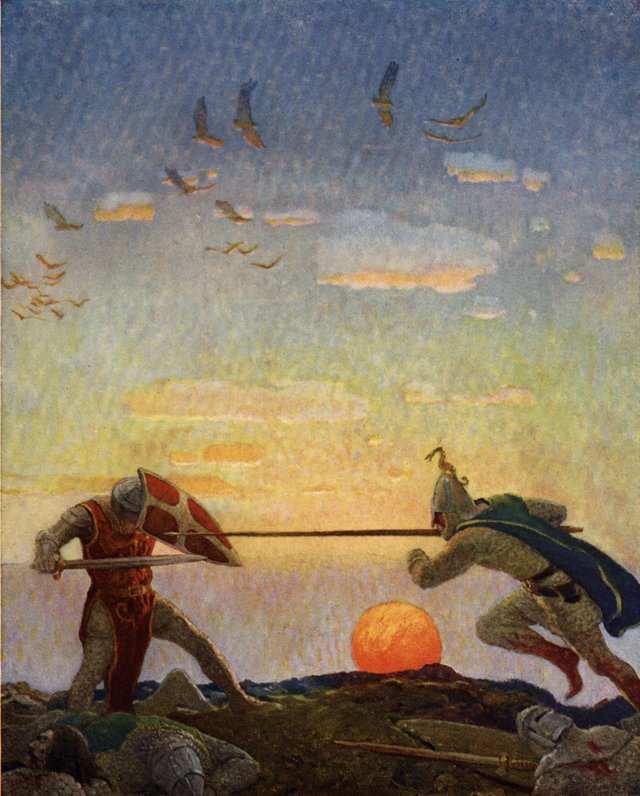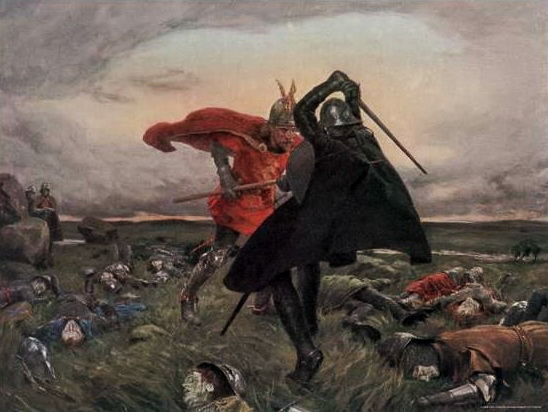My Original King Arthur String Quartet Final Movement: "The Death of Arthur" Inspired by the Art Work of N.C. Wyeth
Hello everyone! As promised, this article will discuss the last movement of my King Arthur string quartet. Sadly, this movement is a depiction of the death of King Arthur in a duel with Sir Mordred (more on the story later). But, none-the-less everybody dies, even King Arthur, and, in this case, this portion of Arthur's story provides a convenient point for the quartet (both in plot and mood). So, without further adue, let's get into the art and the music!
Art
This painting depicts the fight between Sir Mordred and King Arthur in a field riddled with the bodies of Arthur's fallen comrades as well as Mordred's. The scene really is quite beautiful considering it is a depiction of a battle that kills both participants. I am quite fond of the setting sun as well as the birds flying in the sky. It appears to me that Wyeth paid particular attention to the backgrounds of these scenes (which is quite nice). This scene doesn't read like a death scene the way it is drawn, and I think this is good. The sunset doesn't change color because of the death of any one man, nor do the birds sing a more mournful tune. As a result of this particular detail, I think this scene really shows Wyeth's maturity as an artist. After this painting, I will include the same scene depicted by William Hatherell. You will notice a much darker mood in the background, despite seemingly depicting the same event at the same time of day. Here is the picture:

It bears the caption:
"Then the king. . . ran towards Sir Mordred, crying, 'Traitor, now is thy death day come'"
Here is Hatherell's depiction.

Notice Mordred's black (evil) clothes in comparison to Arthur's light (good) clothes. A cliche idea; granted by modern standards; this idea might have been quite innovative in the 19th century.
Here is my interpretation:
Story
At this point in the story, a huge battle has occurred. The only survivors of which are Arthur and a few of his men, and Sir Mordred, the traitor. Sir Lucan tried to convince Arthur to leave in order to live and fight another day. But, King Arthur refuses to let a traitor like Sir Mordred live. King Arthur charges Sir Mordred with a spear and the two fight until eventually mortally wounding one another.
What's going on in the Music?
I was quite nervous going into this particular scene. I considered the work I'd done up to this point to be fairly decent, and didn't want to leave a bad final impression. On top of this, it is an emotional scene to depict. I have spent five movements getting to know Arthur, and, death has always been a hard concept to grasp. Beautiful memorials have been composed, and contrasting fiery death music criticizing the injustice of mortality. But, the main question came to be: how do I, as a composer, depict the death of such a beloved character? I decided to draw influence from the Lacrimosa movement of Mozart's Requiem. I have long felt (in my own opinion) that this is the most sincere depiction there is of death and, more importantly, mortality that there is. I think the main reason for my drawing this conclusion is the fact that Mozart was on his death bed as he wrote it, and only managed to complete (as far as we know) the first 8 measures. When I listen to those measures, I don't hear the ego or false humility of some man, I hear a plea to his God for forgiveness, a spark of hope for a lasting legacy after death, and an acknowledgement of all that was granted to him through life, all iterated through the pen and voice of Mozart. In this movement, I did my best (which was not a lot) to try to portray this rather than merely writing something angry or sad.
Figuration
The figuration is again quite similar to Mozart's Lacrimosa. I tried to make use of the chromatic scale, and had a similar accompaniment figure (in 12/8) to Mozart's. To touch more on the chromatic scale, I have always associated chromaticism with an eerie sound, almost death like. Especially since discovering the large amounts of it used within the Mozart requiem. So, in this movement I made use of chromatic ideas in order to depict a similar feeling to what I've associated.
Imagery
I always tried to have two main lines in order to depict the two participants in this final fight, both of which end up dying to the other.
Pizzicato Figure Accompanying Arthur Theme
One thing I did in this movement was utilize the Pizzicato technique in the accompaniment to the Arthur theme. I had to use the Arthur theme since Arthur is depicted, and I decided that a Pizzicato accompaniment would offer contrast while maintaining a somber mood. I also continued to have 2 lines through the accompanying sixteenth note figures.
Coda
Lastly, I bring back the coda from the first movement which so queerly veered towards G major. This time, I continued the chromatic ascent in the bass, and landed on the V/ii° in e minor. I think that diminished 5th within the two chord really helps to maintain the death-like feeling as the movement drifts to nothing. On top of this, I wanted to kind of bring the whole quartet full circle with this idea.
Prior Movements and Performance Info
Listed below are hyperlinks to the prior movements as well as information for the performance on August 21st. I'd like to say special thank yous to Mr. Andrew Desiderio, my private theory and composition teacher, and Ms. Jennifer Nicole Cambell, who ran this workshop, for their advice in revising these movements. Thank you also to the Brandywine River Art Museum for hosting this opportunity.
Conclusion
Thanks for reading/listening to this! Writing this quartet has been a tremendously fun, exciting, and, most importantly, worthwhile experience! I appreciate, very much, the feedback and incentive which this community has provided for this project as well as all of my other endeavors. Please remember that feedback is always appreciated! Have a nice night!

(Note) In order to encourage meaningful feedback on the platform, I will check comment trails of users who leave superficial comments (ie "Awesome post," or "Upvoted.") and will mute any users who exhibit a pattern of leaving "spammy" comments.
You are really good at drawing out emotion in your pieces,you can almost feel the life oozing out of the fallen.
Resteemed, your post will appear in the next curation with a SBD share for you!
Your post has been supported and upvoted from the Classical Music community on Steemit as it appears to be of interest to our community. We also support jazz and folk music posts!
If you enjoy our support of the #classical-music community, please consider a small upvote to help grow the support account!
You can find details about us below.
The classical music community at #classical-music and Discord. Follow our community accounts @classical-music and @classical-radio or follow our curation trail (classical-radio) at SteemAuto!
Delegation links: 10SP, 25SP, 50SP, 75SP, 100SP, 150SP, 200SP, 250SP, 500SP, 1000SP
This post was shared in the Curation Collective Discord community for curators, and upvoted and resteemed by the @c-squared community account after manual review.
@c-squared runs a community witness. Please consider using one of your witness votes on us here
1 !BEER Token for you
Hi, greetings to you!